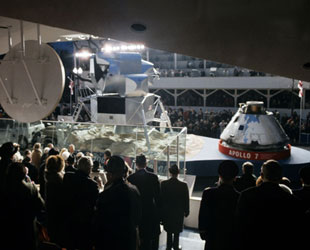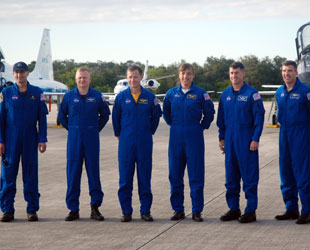January 19, 2009 — On January 20, 1969, NASA rolled out one of its recent space-flown astronaut crews and an example of the spacecraft developed for its future moon missions for the new President of the United States, who was sworn into office that morning.
A similar scene will unfold on Tuesday, 40 years later to the day, as the space agency takes part in the inaugural parade honoring President Barack Obama. It will be only the second time in four decades when humans who have orbited the planet have been included in the procession stretching the distance between the U.S. Capitol Building and the White House in Washington, DC.
Inaugural Apollo crew, craft
President Richard Nixon's first inauguration took place six months to the day before the first Americans would walk on the Moon, although of course, no one knew it that day.
That Monday afternoon, among the many displays, bands and other participants in Nixon's inaugural parade, was a car carrying three men who represented the future history that was to be made a quarter of a million miles away that July.
"My most vivid memory is how cold it was that day," said Apollo 7 astronaut Walt Cunningham, of his and his fellow two crewmates open car ride down Pennsylvania Avenue. "We waited in the home of a Congressman until the last minute, and then climbed under a car robe and smiled like we were enjoying ourselves," recalled Cunningham of the 35 degree weather that day in Washington, in an interview with collectSPACE.
Cunningham, along with Walter "Wally" Schirra, who was one of the original seven Mercury astronauts, and Donn Eisele, who like Cunningham was a first-time flyer, were the first astronauts to test the Apollo command module in space. Their 11-day, highly-successful mission in Earth orbit paved the way for Apollo 8, which returned from the world's first crewed flight to the Moon three weeks before Nixon's inauguration.
Trailing the crew's car in the parade was a NASA float exhibiting a full scale mock-up of the Apollo lunar lander (complete with replica lunar surface and spacesuit-clad astronaut models) and the real Apollo 7 spacecraft.

In this previously unpublished photo of NASA's float in the 1969 Inaugural Parade, the Apollo 7 command module is paired with a mockup of the Apollo lunar module. (Nixon Presidential Library) |
"That was the last time I saw [the command module] until it was received at the Frontiers of Flight Museum in Dallas," explained Cunningham. The craft was transferred by NASA to the Smithsonian in 1970 and then loaned to Canada's National Museum of Science and Technology in Ottawa, Ontario. The spacecraft returned to the States in 2004, when it went on display in Texas.
The parade, like the museum exhibitions, was intended to raise support for the space program.
"We did it to generate enthusiasm for NASA, which I believe it did with the public, but not with Nixon," shared Cunningham. "Actually, NASA did not ask our opinion in the matter."
Space stand-ins
In the presidential parades that followed, NASA was not entirely absent, though its astronauts were.
Nixon's second parade included a replica lunar rover like the type driven by the Apollo 17 crew, the last to walk or drive on the Moon, as a result of decisions made by the President. The mission had just returned to Earth only a month before.
William O'Leary, a public affairs information officer at the Goddard Space Flight Center in Maryland, portrayed an astronaut in the 1977 parade for President Jimmy Carter, standing on a NASA float. Retiring from NASA in 1985 after 23 years of service, O'Leary, 81, died of congestive heart failure in January 2008.
Out-going President George W. Bush's first inauguration in 2001 included a model of a space shuttle in his parade. Two years later with the loss of the first orbiter Columbia, President Bush called for the space shuttle's retirement in 2010.
Though astronauts didn't participate in the parades, some have been invited to the inaugural balls. One astronaut in particular, John Blaha, took a 1997 ball for President Bill Clinton to new heights by appearing via a taped message that he filmed from his home for four months on-board the Russian space station Mir.
Blaha had just missed being there in-person; he touched down back on Earth two days later.
Time for a change

The STS-126 crew will take part in the 56th Inaugural Parade. From left to right: Donald Pettit, Eric Boe, Chris Ferguson, Heide Stefanyshyn-Piper, Shane Kimbrough and Steve Bowen. Not pictured: ISS flight engineer Greg Chamitoff (collectSPACE) |
On December 22, 2008, the Presidential Inaugural Committee formally invited NASA to take part in the 56th Inaugural Parade, capping the space agency's 50 year anniversary. At the same time, it was announced that the crew of the most recent space shuttle mission would join other NASA representatives in the procession.
"That will be a great treat for us, and a great opportunity for NASA," said STS-126 commander Chris Ferguson. He will again lead his crew, which includes pilot Eric Boe and mission specialists Don Pettit, Heide Stefanyshyn-Piper, Steve Bowen and Shane Kimbrough. Joining them will be Greg Chamitoff, who flew home with Endeavour and the STS-126 crew after living six months on the International Space Station.
They won't be the only astronauts, either.
Driving NASA's new Lunar Electric Rover (LER) down the parade route will be four-time shuttle mission specialist Michael Gernhardt. The 12-wheeled concept vehicle can house two astronauts for up to 14 days with sleeping and sanitary facilities.
The LER also has two special ports to which spacesuited astronauts can dock themselves after a moonwalk, which spacewalker Rex Walheim will demonstrate for President Obama.
Pulling up at the presidential reviewing stand at the White House, the plan calls for Walheim to detach himself and step down from the rover, hold up an U.S. flag and salute Obama as a fitting finale to the parade.
"We'll be somewhere near the end," said Ferguson. "We were told not right behind the horses, but close."
Click on thumbnails to enlarge
